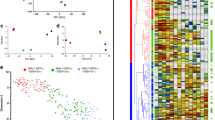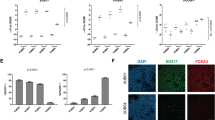Abstract
Embryonic stem cells (ESCs) can be propagated indefinitely in culture, while retaining the ability to differentiate into any cell type in the organism. The molecular and cellular mechanisms underlying ESC pluripotency are, however, poorly understood. We characterize a population of early mesoderm-specified (EM) progenitors that is generated from mouse ESCs by bone morphogenetic protein stimulation. We further show that pluripotent ESCs are actively regenerated from EM progenitors by the action of the divergent homeodomain-containing protein Nanog, which, in turn, is upregulated in EM progenitors by the combined action of leukemia inhibitory factor and the early mesoderm transcription factor T/Brachyury. These findings uncover specific roles of leukemia inhibitory factor, Nanog, and bone morphogenetic protein in the self-renewal of ESCs and provide novel insights into the cellular bases of ESC pluripotency.
This is a preview of subscription content, access via your institution
Access options
Subscribe to this journal
Receive 12 print issues and online access
$209.00 per year
only $17.42 per issue
Buy this article
- Purchase on Springer Link
- Instant access to full article PDF
Prices may be subject to local taxes which are calculated during checkout




Similar content being viewed by others
References
Martin GR (1981) Isolation of a pluripotent cell line from early mouse embryos cultured in medium conditioned by teratocarcinoma stem cells. Proc Natl Acad Sci USA 78: 7634–7638
Evans MJ and Kaufman MH (1981) Establishment in culture of pluripotential cells from mouse embryos. Nature 292: 154–156
Smith AG (2001) Embryo-derived stem cells: of mice and men. Annu Rev Cell Dev Biol 17: 435–462
Shamblott MJ et al. (1998) Derivation of pluripotent stem cells from cultured human primordial germ cells. Proc Natl Acad Sci USA 95: 13726–13731
Thomson JA et al. (1998) Embryonic stem cell lines derived from human blastocysts. Science 282: 1145–1147
Rao M (2004) Conserved and divergent paths that regulate self-renewal in mouse and human embryonic stem cells. Dev Biol 275: 269–286
Herrmann BG et al. (1990) Cloning of the T gene required in mesoderm formation in the mouse. Nature 343: 617–622
Wilkinson DG et al. (1990) Expression pattern of the mouse T gene and its role in mesoderm formation. Nature 343: 657–659
Smith AG et al. (1988) Inhibition of pluripotential embryonic stem cell differentiation by purified polypeptides. Nature 336: 688–690
Williams RL et al. (1988) Myeloid leukaemia inhibitory factor maintains the developmental potential of embryonic stem cells. Nature 336: 684–687
Mitsui K et al. (2003) The homeoprotein Nanog is required for maintenance of pluripotency in mouse epiblast and ES cells. Cell 113: 631–642
Chambers I et al. (2003) Functional expression cloning of Nanog, a pluripotency sustaining factor in embryonic stem cells. Cell 113: 643–655
Li E et al. (1992) Targeted mutation of the DNA methyltransferase gene results in embryonic lethality. Cell 69: 915–926
Cowan CA et al. (2004) Derivation of embryonic stem-cell lines from human blastocysts. N Engl J Med 350: 1353–1356
Yu D et al. (2000) An efficient recombination system for chromosome engineering in Escherichia coli. Proc Natl Acad Sci USA 97: 5978–5983
Suzuki A et al. (2000) Flow-cytometric separation and enrichment of hepatic progenitor cells in the developing mouse liver. Hepatology 32: 1230–1239
Suzuki A et al. (2003) Role for growth factors and extracellular matrix in controlling differentiation of prospectively isolated hepatic stem cells. Development 130: 2513–2524
Ramalho-Santos M et al. (2002) “Stemness”: transcriptional profiling of embryonic and adult stem cells. Science 298: 597–600
Raz R et al. (1999) Essential role of STAT3 for embryonic stem cell pluripotency. Proc Natl Acad Sci USA 96: 2846–2851
Gossen M et al. (1995) Transcriptional activation by tetracyclines in mammalian cells. Science 268: 1766–1769
Hoffmann A et al. (2002) The T-box transcription factor Brachyury mediates cartilage development in mesenchymal stem cell line C3H10T1/2. J Cell Sci 115: 769–781
Rashbass P et al. (1991) A cell autonomous function of Brachyury in T/T embryonic stem cell chimaeras. Nature 353: 348–351
Kubo A et al. (2004) Development of definitive endoderm from embryonic stem cells in culture. Development 131: 1651–1662
Rathjen J et al. (1999) Formation of a primitive ectoderm like cell population, EPL cells, from ES cells in response to biologically derived factors. J Cell Sci 112 (Pt 5) 601–612
Nichols J et al. (2001) Physiological rationale for responsiveness of mouse embryonic stem cells to gp130 cytokines. Development 128: 2333–2339
Daheron L et al. (2004) LIF/STAT3 signaling fails to maintain self-renewal of human embryonic stem cells. Stem Cells 22: 770–778
Acknowledgements
We thank R Benezra, S Choe, NG Copeland, R Eckner, D Melton, K Miyazono, G Tiscornia, and S Yamanaka for reagents; D Buscher, C Kintner, I Oishi, J Sonoda, and A Tashiro for helpful suggestions; H Pineda, T Chapman, and H Juguilon for technical assistance; and M-F Schwarz for help with this manuscript. AS, TM, and KN received support from the Japan Society for the Promotion of Science, and AR and CR-E from the Fundación Inbiomed, Spain. We are also indebted for support to the Salk Institute, the Lookout Fund, the G Harold and Leila Y Mathers Charitable Foundation, and the National Institutes of Health.
Author information
Authors and Affiliations
Corresponding author
Ethics declarations
Competing interests
The authors declare no competing financial interests.
Rights and permissions
About this article
Cite this article
Suzuki, A., Raya, Á., Kawakami, Y. et al. Maintenance of embryonic stem cell pluripotency by Nanog-mediated reversal of mesoderm specification. Nat Rev Cardiol 3 (Suppl 1), S114–S122 (2006). https://doi.org/10.1038/ncpcardio0442
Received:
Accepted:
Issue Date:
DOI: https://doi.org/10.1038/ncpcardio0442
This article is cited by
-
Derivation of stable embryonic stem cell-like, but transcriptionally heterogenous, induced pluripotent stem cells from non-permissive mouse strains
Mammalian Genome (2020)
-
Intrinsic factors and the embryonic environment influence the formation of extragonadal teratomas during gestation
BMC Developmental Biology (2015)
-
Generation of organized germ layers from a single mouse embryonic stem cell
Nature Communications (2014)
-
Regulation of organogenesis and stem cell properties by T-box transcription factors
Cellular and Molecular Life Sciences (2013)
-
Overexpression of Nanog protein is associated with poor prognosis in gastric adenocarcinoma
Medical Oncology (2012)



